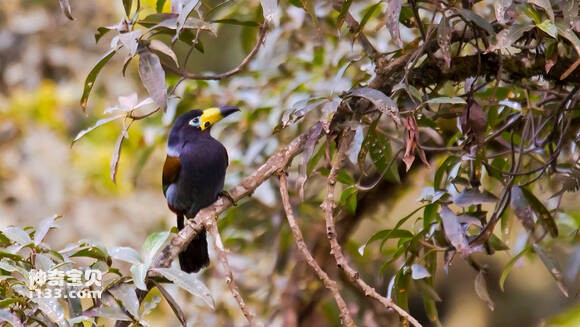Andigena cucullata
IUCN
LCBasic Information
Scientific classification
- name:Andigena cucullata
- Scientific Name:Andigena cucullata,Hooded Mountain Toucan
- Outline:Climbing birds
- Family:
Vital signs
- length:No textual research information is available
- Weight:No textual research information is available
- lifetime:No textual research information is available
Feature
The structure of the mouth bone is unique
Distribution and Habitat
It is found in South America from southeastern Peru to central Bolivia.
Appearance
The Guanshan Toucan is a medium-sized climbing bird, slightly resembling a hornbill, with a large but lighter beak, serrated edges, and a brightly colored beak. Feathers are also colorful. The long mouth takes up one-third of the body length, like a mouth knife. The mouth is very beautiful, the upper part is yellow, slightly pale green, and the lower part is dark blue. Its body color is very bright, coupled with a circle of white feathers around the eyes, dark blue head, cheeks and chest, brown back and wings, formed a harmonious and colorful beautiful picture.
The beak, despite its size, weighs less than 30 grams. The structure of the mouth bone is very special, it is not a dense entity, the outside is a layer of crust, through the middle of extremely fine fibers, porous spongy tissue, filled with air, so that it does not feel heavy pressure.
Details
Andigena cucullata, Hooded Mountain Toucan, is a medium-sized climbing bird.

Guanshan Toucan is gregarious and prefers to live in treetops. It is also the noisiest forest bird, capable of making loud rumbles, trumpets and screeches. Its nest is built in a hole high in a tree. When eating, always peck the food with the tip of the mouth first, then tilt the neck, throw the food upward, and then open the big mouth to accurately put the food into the throat, without having to go through the long mouth and spend time in the process of "swallowing". The bird is omnivorous, feeding on fruits, seeds, and insects, and sometimes raiding the nests of small birds, eating eggs and chicks。

The crested mountain Toucan nests in tree cavities. - Lay 2 to 4 eggs. Smooth white eggs are piled in unlined holes and hatch in about 16 days. The hatchlings are completely naked, take at least three weeks to open their eyes, and begin to live their lives about 45 days after hatching.
Protect wild animals and eliminate wild meat.
Maintaining ecological balance is everyone's responsibility!








